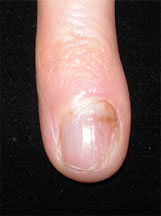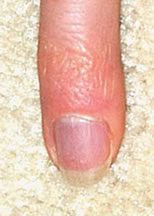Fingernail and Fingertip Fungus Infections
Fungus Infections in General
Nail fungus infection is a condition called onychomycosis ("onycho" refers to the nail, and "mycosis" means fungus). It is fairly common, with about 12 million Americans being affected. We all have a variety of microorganisms, including bacteria and fungi, growing in and on our bodies. Some of these are absolutely essential to our health (for instance, the bacteria in our intestines that assist in digestion). Others may cause illness (infection) whenever they invade us, or only if they multiply rapidly and out of control.
Fungal infections are caused by fungi, which are microscopic organisms. (Technically speaking, fungi are not plants but they are not animals, either; they are in their own kingdom; see a webpage I have written on them here). We all have fungus growing on our skin, particularly on our feet, where the condition is called "athlete's foot." Fungus loves the growth conditions of damp, moist, and lots of food, and the skin of our feet is the perfect location (the "food" is the dead skin cells that are sloughed off by the millions every day). Other common fungal infections include mold-like fungi (dermatophytes, causing tinea infections) and yeast-like fungi (such as Candida). Tinea infections include jock itch, ringworm, and tinea capitis. Candida (yeast is the spore form of fungus) infections include diaper rash, oral thrush, cutaneous candidiasis, and some cases of genital rashes. The fungus is usually not a problem, since our immune system fights back and the fungus stays on the outside of our bodies. Fungus is a problem when there is a breakdown in our defenses.
Fungus Infections of the Fingernail
The fingertip is a highly specialized structure, with many highly-evolved features.

The illustration above shows the anatomy of the fingertip. There are also additional specialized tissues just around the nail, in order to help fight nail fungus infections. In terms of evolution, this should make sense. Originally, nails were claws, and animals would get dirt forced under and around their claws as they dug, fought, etc. The nail area developed many specialized defenses against the invasion of bacteria and fungus.
Nail bed infections usually start when there is some breakdown in the body's defenses, such as an immune system illness, fingertip crush, nail fold laceration, etc. The fungus may get a start because of a bacterial infection.
The fungus, typically caused by a species of Trichophyton fungus, feeds on keratin, the protective outer layer of nails, hair and skin. If the fungus gets some advantage over our fingertip defenses, it may start growing on the keratin of the skin under the nail plate (the part that your trim with a fingernail clipper). There is a buildup of organic waste material and the body can react with over-production of keratin, both of which forces the nail to separate from the nail bed. This causes the typical yellow color under the nail and partial nail separation. It can also result in the thickened, distorted nail plate. Sometime the soft tissues around the nail will be just a bit red and tender.
Eventually, the entire nail separates, resulting in partially destroyed, yellow nail.
Treatment
Once fungus gets into the nails, it is very difficult to treat, but if you are persistent you can beat it. My choice is to treat it with topical ointments, but I want to review the alternatives so you understand why this is my choice. Some kind of treatment is necessary, as it will not go away by itself, so don't just ignore it.
Fungal infections of finger nails can be treated by taking pills called griseofulvin. The pills must be taken for six months to one year and have side effects. These include headaches, nausea, and rare reversible liver damage or blood disorders. You can not drink alcohol if you are taking griseofulvin. A course of treatment costs approximately $350 and has a 50-70% chance of curing the condition.
A new medication, terbinafine, is now available for the treatment of toe and finger nail fungal infections. Terbinafine is taken once a day for 6 to 12 weeks. This medication has less side effects than griseofulvin, but there still is the possibility of side effects. A 12 week course of treatment costs $500 and has a 50-70% chance of curing the condition.
Removal of the nail will not get rid of onychomycosis. When the new nail grows in, it almost always becomes reinfected, so this is not a good choice.
So what do I recommend? I suggest that you try topical ointment. It is slower, takes more work on your part, and needs to be done over a very long period of time (six months to a year) and may need to be done periodically in the future. However, the side effects and cost of the other treatments convinced me that when I had a fungal infection of my toenails, I wanted to try the ointment. It worked for me, so I started trying it for my patients who had fingernail infections. It has been successful in every case so far, so I recommend that you try it, too.
Lotrimin cream is available without a prescription at your local drug store, or I can write you a prescription. Clean your fingernails (and toenails, too, if you want) every day. Don't push up the cuticle and do not wear false nails. Do not clean the nail area with solvents (fingernail polish remover, for instance). Rub some of the Lotrimin into the nail area, especially under the nail plate. Squoosh it around (do you mind if I make up a word?) so that it gets under the nail as far as possible. It can't help fight the fungus under the nail if you don't get it in there!
If we can make the environment hostile enough for the fungus, our body's natural ability to heal itself and fight off the fungus will win the day. Don't be discouraged if you don't see instant results: you won't. It will take a few months before you see much of a change. Be persistent and you will have a normal nail one day.
Fungal Infections of the Skin Around the Nail
An infection of the skin around the nail is called a paronychia. These can be due to bacteria or due to fungus. Often, after a bacterial infection has caused the body's defenses to be disrupted, the normal fungus on our skin invades the tissues. Simple treatment may cure the bacterial infection, but the fungal infection persists, as it is much more difficult to treat. Anti-fungal pills can be tried, but sometimes does not work. At time, we are forced to try another approach, surgical removal of some of the infected tissue. This procedure is called a marsupilization.
This is the case of a 39 year old veterinarian who had a chronic fungal infection for eight years. It was caused, in part, by needing to get her hands contaminated and wash them many times a day. Oral medication did not work. She had pain in her fingertip as well as the deformity of the nail margin (see below).
 |
 |
| She had surgery to remove the infected skin, and the wound was left open to heal by itself (the incision was not closed and there was no skin graft placed). The skin healed and closed in two weeks. The image on the right is from six months later, showing that the infection did not return and the nail fold grew to almost normal. | |
Other Resources
Nail infections are quite common, so there is a lot of information available on the Internet. Be careful of what you read. Remember the precautions I gave on the Links Homepage. Warning signs of bad information are sites that sell you something, that are supported by only one company selling something, etc. If you see information that contradicts what I told you, download a copy and bring it in when you see me.
Here are three sites that I found on January 30, 2002. They seemed to have good information at that time. However, since they may have changed since then, and I have no control over their information, you must view the data with caution.
University of South Florida Family Medicine
Nail Fungus Organization
National Skin Care (Singapore)
